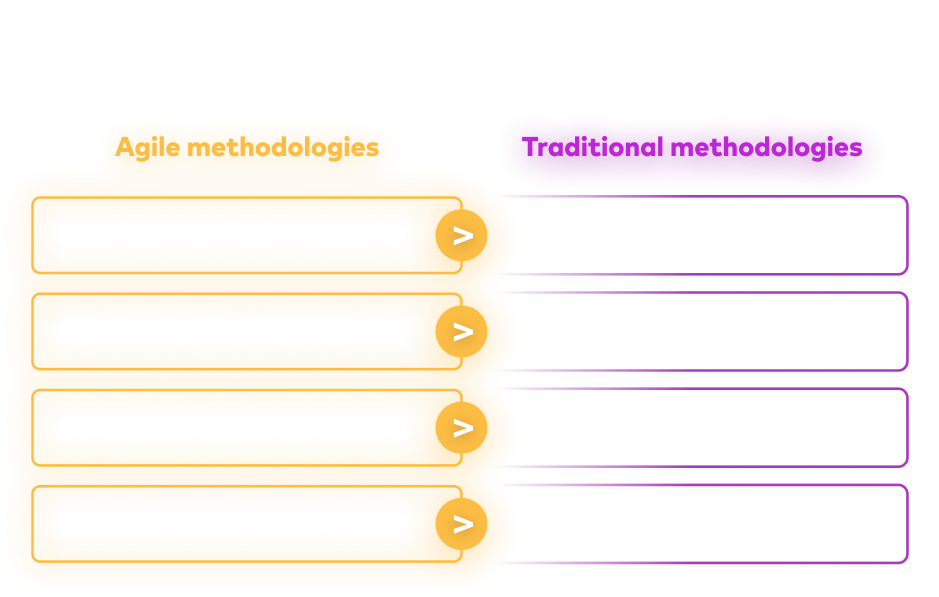
Think you work Agile? Newsflash, You Probably Don’t.
How Agile Actually Works
You might hear some companies claim that they work using the agile methodology – that might be the first red flag. They may be claiming to be Agile, but are they?
Agile isn’t a methodology, but a set of values and principles that actually avoid recommending or prescribing a particular method. Being Agile means that you can work with different methods that suit your business and project best, rather than adhering strictly to one method.
The values and principles of Agile are more a philosophy and culture, rather than an exacting guideline of methods that you’re supposed to follow – if that was the case, it wouldn’t be so “agile”, would it?
The meaning of Agile is to be flexible and adaptable, and that’s exactly what being Agile requires. It’s about continually adapting to circumstances, and constantly making improvements in particular projects, but also in the overall way in which teams work.
Instead of telling you what to do, Agile gives you these values and principles that your team can use to decide what’s best, and what you should do – examples of some of the most common methods that are used in Agile companies are stand up meetings (stand-ups) and retrospectives (retros). Again, these are methods that can be used in an Agile environment but are not strictly stated as necessary to be Agile.
Being Agile is more about an attitude. If your business focused on doing agile, rather than actually being agile, you’re already on the wrong path. Being Agile is all about applying the philosophy outlined in the Agile Manifesto, which emphasizes adaptation and continuous improvement.

Common Misconceptions About Agile
Companies that want to be more adaptable or be more up-to-date with current trends are often rushing to becoming Agile. But in a lot of cases, we find that the way they’re implementing the Agile philosophy is actually making them less agile!
There are a few reasons this is happening. In some cases, we see that these Agile companies are misunderstanding some of the key elements in the Agile Manifesto. In other cases, we find that these businesses are employing methodologies like SCRUM or Kanban, which, of course, can be used in an Agile environment, but on their own do not automatically make a company Agile.
In 2018, Harvard Business Review stated that they had been analyzing the practices of engineers over 500 different organizations. They discovered that what’s happening in practice with Agile, is quite different than the 4 core Agile principles.

Some examples of these misconceptions are:
- Based on Harvard Business Review’s research, it was found that processes and tools have become the driver for work, rather than individuals and interactions. This contradicts the first main principle in the Agile philosophy. If this is the case in a business, it would mean that they aren’t truly creating an Agile environment.
- It’s also been found, in a large number of companies who were a part of the research conducted, that documentation is frequently made a priority over working software. This meant that the time-to-market was longer than intended for many projects. This directly counters one of the 4 main principles of Agile, “Working Software over Comprehensive Documentation.”
- Mistaking working in SCRUM or other methodologies for being a business working Agile. Just because you employ SCRUM, Kanban or any of these other processes does not mean you are working Agile. These processes can also be employed in the waterfall model.
- Isolating business and development teams, thinking that they are two completely different entities…this is a huge mistake. When working in Agile, it’s important to avoid misunderstandings, and everyone involved in the company should be able to easily and effectively receive information to adjust requirements for each project. Practical communication practices, company-wide, are really important to being Agile.
- Doing retros, but only about the work in projects. Believe it or not, retros are also intended for the team and processes! This time should be used to improve and update your processes within your team, to make sure you aren’t wasting time. They give you a great opportunity to fine-tune your team processes and receive feedback about what’s working and what isn’t.
- Misinterpreting the Agile Manifesto’s point on, “Responding to change over following a plan” to mean, “Don’t have a plan.” This could not be further off from what the manifesto is trying to say. Without a plan, teams don’t know how to prioritize their actions, or how to invest their time responsibly and efficiently. There needs to be a plan, but also the flexibility to adjust that plan as things move forward.
- Adopting the idea that there are universal “best practices”. What works from one team, or in one company, might not work for another. Each project might also require different practices. Teams are made up of an array of unique personalities, environments and skills, so it’s safe to assume that the best practices would also need to be adjusted accordingly. This is where retros come in handy! 😉
It’s not really about “doing agile” or “being agile” but “becoming more agile”
Bertil Muth, freeCodeCamp

Becoming More Agile
You can’t have both perfect predictability and unlimited responsiveness to change…it’s just not possible! To be truly Agile, you need to have room for flexibility and understand that unique circumstances require unique processes and solutions. This doesn’t mean you have to develop all-new processes for each new team or project – you can work on the ones you already have and try to improve them.
I know we’re making it sound like, “You don’t need to completely overhaul your business and the way it runs, to become more Agile,” but it really depends on your current situation. It fully depends on how you have your teams organized at the moment.
For example, teams should be organized to emphasize collaboration, while also implementing communication tools that will be productive. For Agile to be effective, teams and team members need to be able to contact and reply to one another with swiftness and ease.
Key decision-makers, including middle management, need to understand the values and principles of the Agile Manifesto, and wholeheartedly believe in them. If there is anyone who doesn’t see the value of being Agile, then it will be more difficult to use Agile effectively. It becomes especially challenging, if not impossible, if management isn’t prepared or willing to invest time into regular feedback and daily communication.
Your teams should also be questioning their processes constantly. It’s not about implementing a process, and then saying, “Let’s call it a day!” If you want to be truly Agile, you need to guarantee that you will iterate your processes. It’s important that you continue improving them to adapt to the ever changing environment.
“If you want to implement Agile, do it right or don’t do it at all.” (Clutch) You need to make sure that the Agile culture is a good fit for your business model and your business values. You’ll also need to make sure you are building teams that align with the core values and principles from the Agile manifesto. Transforming a whole organization means that everyone should share the Agile mindset – and that everyone is willing to work in close cooperation with each other.
Article written by Sona Kerim
Sources:
https://www.youtube.com/watch?v=ZZ_vnqvW4DQ
https://www.infoworld.com/article/3074332/15-signs-youre-doing-agile-wrong.html
https://agilemanifesto.org/principles.html
https://www.cleanpng.com/png-agile-project-management-agile-software-developmen-2839716/
https://clutch.co/developers/resources/why-agile-doesnt-work-for-your-company
https://hbr.org/2018/10/why-agile-goes-awry-and-how-to-fix-it


